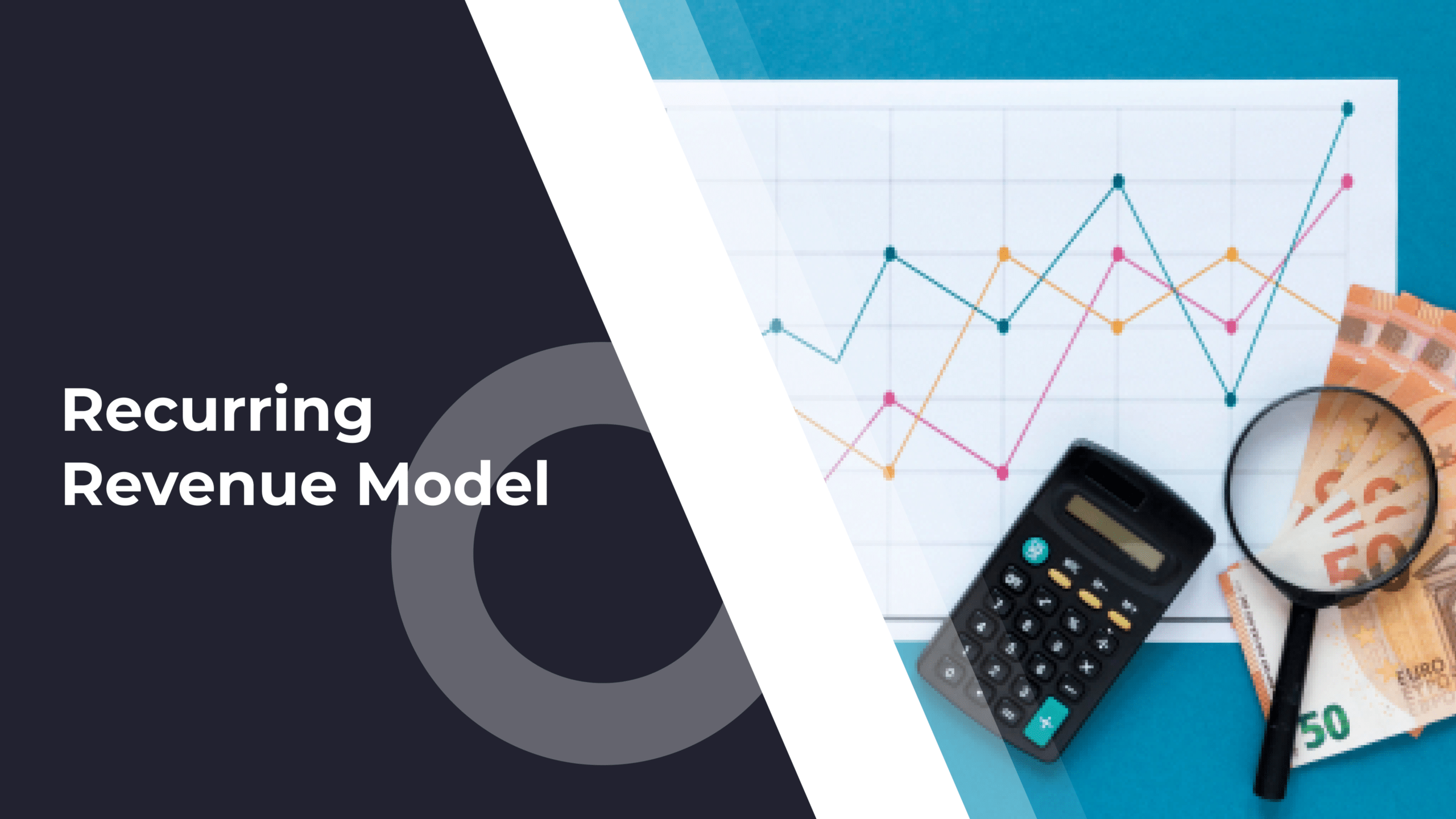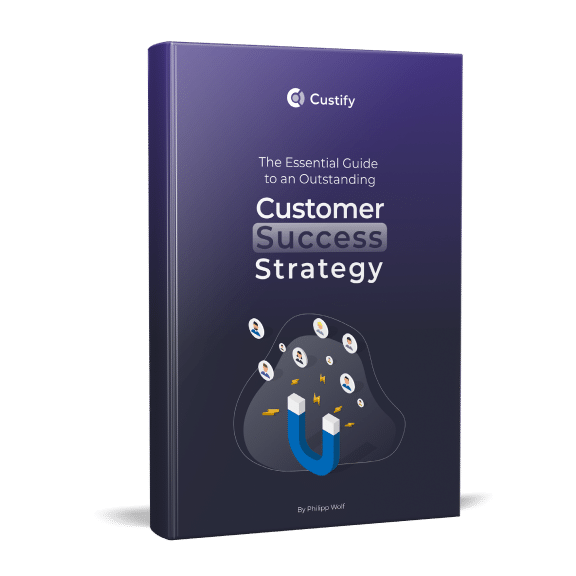When your customer base is growing exponentially, it feels like you’re juggling plates. One misstep and everything comes crashing down. Enter: customer scorecards.
Customer scorecards are an easy and elegant way of keeping track of customer health and outcomes at scale. So today, I thought it high time we discussed:
- What customer scorecards are, how they’re used in customer success and service.
- How to make your scorecards truly valuable for your organization and customers.
- The step by step guide to building your customer scorecards, what needs to be on them, and how to keep them up to date.
- Some confusions between CS scorecards and other types of scorecards that may nonetheless be useful for you.
What Is a Customer Scorecard?
Customer scorecards are simple tools for monitoring customer health and outcomes over time. Often called customer success or customer service scorecards, they allow customer-facing team members, such as CSMs or support agents, to keep a comprehensive view of customer data and stay laser-focused on their goals.
What Does a Customer Scorecard Include? [+ Example]
Customer scorecards typically include information regarding account basics, product usage, customer satisfaction, customer service, and revenue metrics like MRR / NRR. Scorecards strike a balance between customers’ desired outcomes and business objectives.
Here are some key elements that often show up in customer scorecards:
- All health scores for that customer
- Queued tasks for that account
- CSM ratings and notes
- Company details
- Communication history
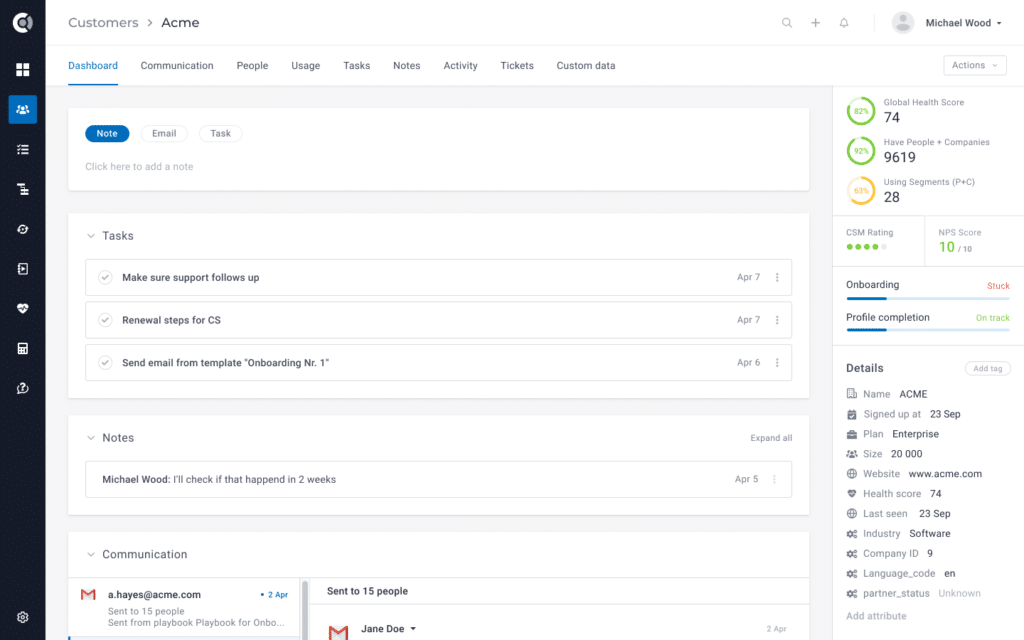
Why Use Customer Scorecards? Who Benefits the Most?
All customer-facing teams benefit from customer scorecards. Now, depending on who leads the scorecard effort, there may be slight differences. On the whole, however, customer success scorecards are great because they:
- Allow you to be more proactive in customer interactions
- Help you act to retain customers and prevent churn risks
- Enable support to have a clear picture of the account at all times
- Help grow expansion by showing new opportunities clearly
- Aligns the entire team around customer objectives
- Matches account tasks with account performance
What Turns a Customer Scorecard from Good to Great
While customer scorecards can be useful even with minimal data, they can easily become just an extra item on the agenda for CSMs without offering the benefits listed above.
To really take your customer success scorecards to the next level, make sure they’re:
- Based on real goals. Have processes in place to accurately identify customer goals – don’t rely solely on what customers say, sometimes their goals are more complex than they think. At the same time, know what your business goals are. Both should be represented through clear KPIs on your customer scorecards.
- Using accurate data. Working with good data is foundational to your success. Following data hygiene practices is becoming essential and you should always make sure your datastreams are correctly set up and transmitting accurate numbers.
- Tracking everything at a glance. Scorecards are good because they distill mountains of information into digestible, bite-sized numbers that quickly tell you how you’re doing and how your customers are doing. So remember to add those KPIs to the scorecards and keep track of everything that’s important to you.
- Putting the customer first. At the end of the day, it’s all about customer value, whether you’re actually delivering it, and how you’re delivering it. Scorecards need to show that kind of customer focus.
- Enabling you to be proactive. Properly constructed customer scorecards will let you know when something is off. Either through automation or just health score signals, you should see when it’s time for you to step in.
- Taking advantage of automation and AI. Automation can help send notifications or execute specific steps whenever a health score drops below a certain threshold. AI can help with customer summaries, so you don’t have to always dig through the data to know what’s up.
- Constantly updated and improved. It is a poor tactic that which is never updated. You should take great care to ensure you’re not working on obsolete customer scorecards – see how customer preferences evolve, work with QBRs, track their product activity, and update scorecards periodically.
Let’s Build a Customer Success Scorecard – Step by Step
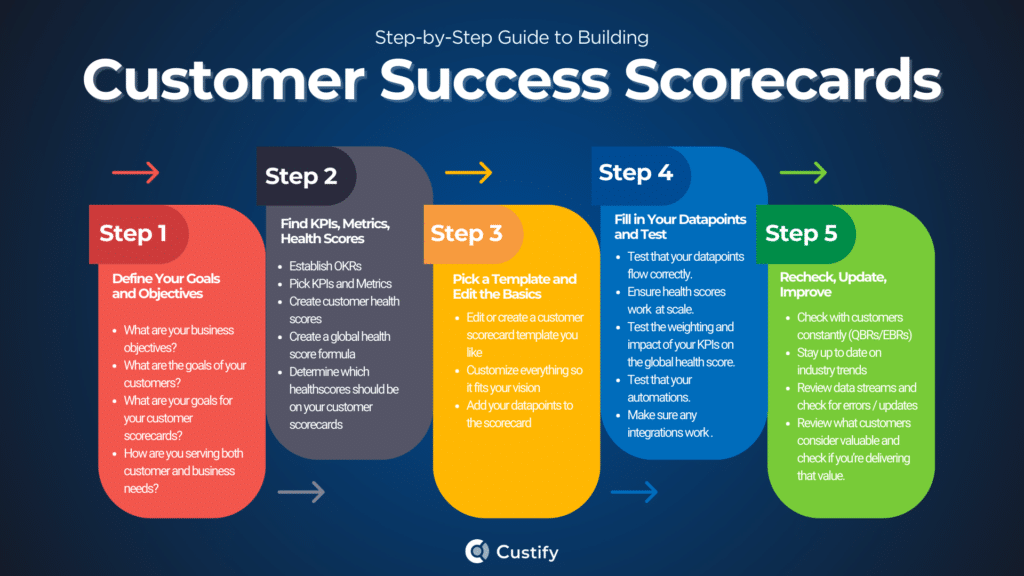
Step 1. Define Your Goals and Objectives
Start with a few questions. Ask yourself:
- What are your overall business objectives? What about your financial goals? Are you accounting for those in your scorecards?
- What are the goals of the customer(s) for which you’re making the scorecard?
- What are your goals for your customer scorecards initiative? How are you serving both customer and business needs?
These three foundational questions will help you zero in on your customer success strategy moving forward.
Step 2. Pick the Correct KPIs and Metrics for Health Scores
Then, move on to KPIs and health scores. Approach these methodically:
- Determine your OKRs (objectives and key results), basically translating customer and business goals into quantifiable metrics.
Find the KPIs that move the needle on your OKRs. - Create customer health scores – determine what high performance and low performance means and weigh your health scores accordingly.
- Create a global health score for the customer. This will be the big health score for that customer that you should have front and center of your customer scorecard. Think about which KPIs will go into the global health score equation and their impact will be.
- Lastly, determine which health scores you want to add to your scorecards.
Step 3. Pick a Template and Edit the Basics
Next, find a customer scorecard template you like, or build your own, and customize it to your liking.
There are plenty of scorecard templates online, but from my experience they’re very specific to one type of organization or another, or one type of customer or another. They’re good for inspiration, but not very useful to use as-is.
So I would recommend you either go for a customer success software like Custify, which offers a clean, customizable dashboard you can tweak to your liking, or create a simple spreadsheet or slide yourself where you gradually add everything you need.
Step 4. Fill in Your Datapoints and Test Your Scorecard
The logical next step is to test your scorecard. Start using it to monitor customers, see what’s missing and what would be nice to have and come up with a final version that suits your customer base and your overall business objectives.
Some best practices here:
- Test that your datapoints flow correctly into your scorecard.
- Ensure that health scores work correctly at scale.
- Test the weighting and impact of your KPIs on the global health score.
- Test that your automations work correctly.
- Make sure any integrations work – such as with your email client or other support channels.
Step 5. Recheck, Update, Improve
Lastly, have a well-defined process for updating your scorecards. That means:
- Checking with customers constantly to see their current objectives, such as through QBRs or EBRs.
- Keeping an eye on the industry and staying up to date on current technologies (like using AI).
- Periodically reviewing your data streams to check for inconsistencies and potential improvements, and new integrations that can help.
- Look at the evolution of what customers consider valuable. Over time, customers’ needs and wants change, and they might require a different CS strategy to keep them from churning. This can depend on the development stage of their organization, current lifecycle stage, usage level, or other factors.
- Through your scorecard updates, you should look to improve your value delivery, so you can ensure customer loyalty for the foreseeable future.
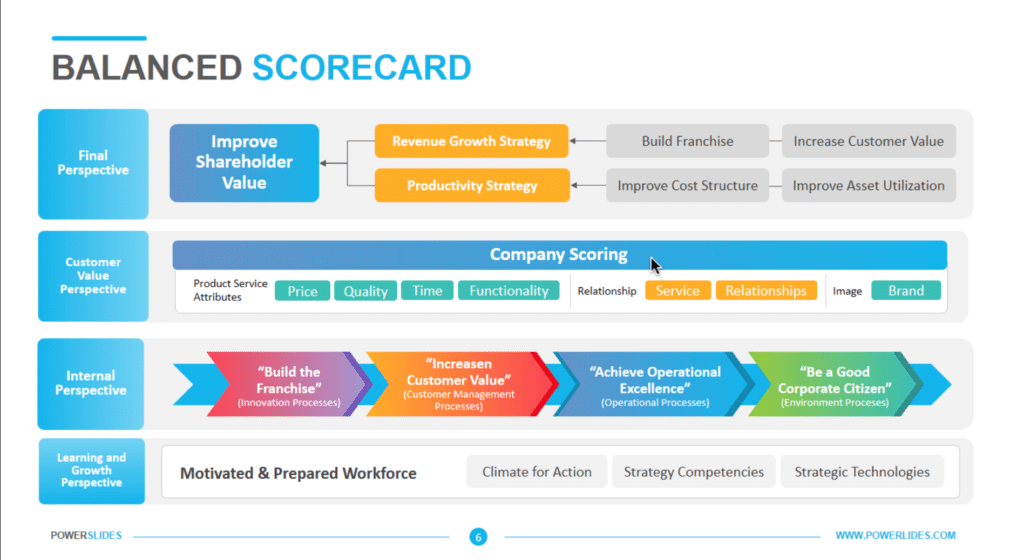
Customer Scorecards – Misconceptions, Mistakes, and Solutions
1. Siloed Data
A common mistake that can lead to inaccurate or not very useful scorecards is siloed data. That means data that’s too divided between multiple departments and unable to be accessed for the purpose of creating your scorecard.
Some examples:
- Product data that doesn’t reach the customer success team
- Sales data that never exits the CRM and can’t be used for customer service
- Customer service resolutions that never reach customer success
These situations, and others like these, are clear indicators of a disconnect and lack of efficiency within your organization.
What can you do?
Before putting together your customer scorecards, determine your stakeholders and the datapoints you need. Then, ensure all those stakeholders have access to those datapoints, and add the ones you need to your scorecards. Lastly, ensure all stakeholders are also able to view those scorecards.
2. Success vs Service vs Employee Scorecards
The term “scorecards” can be used to describe a few different types. It’s important to clarify which is which before you begin the process of creating your own.
- Customer success scorecards. Focused on providing customers with value, reducing churn, fostering good customer relationships, and securing expansion.
- Customer service scorecards. Focused on customer service performance, customer satisfaction, maintaining good customer relationships, and providing adequate support during critical customer journey stages.
- Employee scorecards. These are entirely distinct from the previous two, focusing more on measuring the performance of internal team members. You might’ve heard about these as:
- Customer service agent scorecards. Specific employee evaluation scorecards designed to determine how well your support agents are performing compared to some KPIs.
- Customer success manager scorecards. CSM scorecards are still meant to evaluate CSM performance, but are typically more high-level, measuring things like customer churn rate, MRR, NRR, and growth compared to specific industry benchmarks. CSM scorecards also often contain specifics about the accounts that particular CSM owns.
3. Information Overload
Too much information is never a good sign. However, it’s an easy trap to fall into: after all, you want to know how many times customers log in, how many times they used your core features, how many times they got stuck in their workflow – but the more elements you add to this list, the more difficult it will be to draw truly actionable conclusions.
What can you do?
You should ensure you condense your customer scorecards to the most essential elements that can truly give you a picture of an account without too many distractions. If you need more information, you can always access your full customer success dashboard.
4. Not Following a Strategy
Customer scorecards can be useful as a standalone solution for customer success. But they work much more effectively as part of an integrated strategy.
With a strategy in place, you will immediately know:
- Your customer and business objectives
- Your data governance procedures (hygiene and management)
- How often you will need to update your scorecards
- And, with the help of your customer success platform, how scorecards can help with churn reduction and account expansion
What can you do?
For any serious customer success initiative, take the time to build a full customer success strategy. If you’re using Custify, our team is here to help every step of the way with advice and technical support.
Plan for Efficient Customer Interactions with CS Scorecards
To sum up, customer scorecards are an excellent way of condensing information into bitesized, easily-accessible dashboards.
Customer scorecards help align your team on the same financial goals, business objectives, and customer-centric approach. Something else you could use for that kind of an alignment is Custify – a customer success tool where you take the forefront. Sign up for a demo today – no commitment required – and let’s see how we can take your SaaS business into the future.


